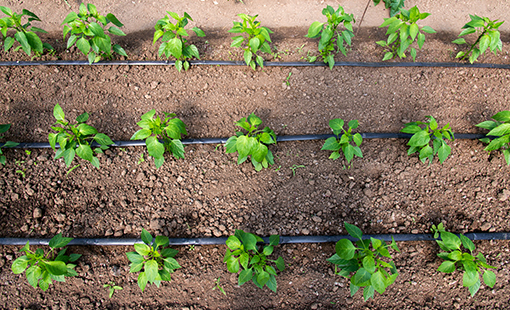
How to Use a Soaker Hose
August 18, 2022
When used correctly, soaker hoses can save you water and simplify your garden maintenance.
- Find the Right Site
Success with soaker hoses relies on using them correctly, and an important part of that is putting them in the right spot. Soaker hoses belong in garden beds. For lawn watering, use a sprinkler, and use drip irrigation on steep slopes or when you’re ready for a more efficient irrigation method. - Start at the Faucet
Always connect a backflow preventer to your faucet first, unless you have a newer faucet with a built-in prevention device. Next, connect a timer to water just enough each time. Add a pressure regulator (10 or 12 psi) before attaching your garden hose. - Too Long is Wrong
The maximum length for an effective soaker hose is 100 feet. Purchase the length that best fits your planted areas and lay your soaker hose only in these areas. Use a garden hose to connect your soaker hose to the faucet. - Keep it Level
Soaker hoses deliver water most uniformly on level ground. They don’t allow water to seep effectively on slopes or in vertical positions like rockeries. If you have level beds at different heights, snake soaker hoses through the beds, then use solid hose and fittings to connect the soaker lengths together to form a continuous line no longer than 100 feet - Use Correct Spacing
Lay lines 12-18 inches apart on sandy soil and 18-24 inches on loam or clay soil. Keep the soaker hose at least 1-2 inches from the base of established plants. But with new plants or annuals, lay the hose closer to the plant and move it away from the base as it grows. - Slow the Flow
Turn the faucet on just enough so the entire hose is seeping but not spraying. The amount may vary for every faucet, so try turning it on a quarter turn first and adjust up or down as necessary. - Perfect Your Timing
Start by running your soaker hose about 30 minutes twice a week. (Annuals and vegetables may need to be watered every other day.) After a watering day, check your soil to see if the moisture has penetrated several inches, then adjust accordingly. When you find the magic number for your conditions, use a timer to water the same number of minutes every time. Keep in mind that too much water can cause just as many plant health problems as too little water.
Information courtesy of SavingWater.org

 Adams Fairacre Farms
Adams Fairacre Farms